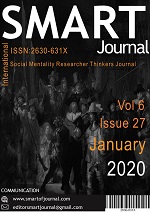Author :
Abstract
Amaç: Çalışma öğrenci ebelerin sağlık okuryazarlığı düzeyini belirlemek amacıyla yapılmıştır. Yöntem : Çalışma kesitsel tipte yapılmıştır. Araştırmanın verileri, “Kişisel Bilgi Formu” ve “Sağlık Okuryazarlığı Ölçeği” ile toplanmıştır. Verilerin değerlendirilmesinde; Yüzde, Ortalama, Mann whitney u testi, Kruskal Wallis testi ve ANOVA kullanılmıştır. Bulgular: Çalışmaya 211 öğrenci katılmış olup yaş ortalaması 20.83±2.23 dür. Katılımcıların toplam ölçek puanı 110.16±12.50, erişim alt boyut puanı 22.12±2.92, anlama alt boyut puanı 30.97±3.93, değerlendirme alt boyut puanı 34.95±4.60 ve uygulama alt boyut puanı 22.11±2.95 dir. Öğrencilerin medeni durum, sınıf düzeyi,yaşadığı yer, sağlık güvencesi, anne ve babanın eğitim düzeyi, anne ve babanın çalışma durumu, mesleği isteyerek seçme, kronik hastalık varlığı ve ilk başvuru yapılan kurum ile sağlık okuryazarlığı arasında anlamlı ilişki bulunmamıştır (p>0.05). Sağlık sorunu olmasada hekime başvuranların başvurmayanlara göre, sağlık haberlerini takip edenler etmeyenlere göre sağlık okuryazarlık puanı anlamlı derecede yüksektir (p<0.05). Sonuç: Öğrenci ebelerin sağlık okuryazarlığı puanı yüksek bulunmuştur. Sağlık bilimleri fakültelerinin sağlık okuryazarlığı toplumun diğer bireylerine göre yüksektir. Fakat toplumsal sağlığın korunması ve geliştirilmesi için tüm bireylerin sağlık okuryazarlığı düzeyi iyi olmalıdır. Bu konuda toplumun eğitim düzeyine ve kültürüne uygun eğitimler planlanmalıdır.
Keywords
Abstract
Objective: The aim of this study was to determine the health literacy level of student midwives. Method: The study was conducted in cross-sectional type. The data of the study was collected with "Personal Information Form" and "Health Literacy Scale”. In the evaluation of the data; Percentage, mean, Mann Whitney U test, Kruskal Wallis test and ANOVA were used. Results: 211 students participated in the study and the mean age was 20.83 ± 2.23. Total scale score of the participants was 110.16 ± 12.50, access sub-dimension score was 22.12 ± 2.92, comprehension sub-dimension score was 30.97 ± 3.93, evaluation sub-dimension score was 34.95 ± 4.60, and application sub-dimension score was 22.11 ± 2.95. No significant relationship was found between the marital status, class level, place of residence, health assurance, education level of the parents, working status of the parents, voluntary selection of the profession, presence of chronic illness and health literacy (p> 0.05). Although there were no health problem, health literacy scores of those who examined by a doctor significantly higher than those who do not examined by a doctor, and also health literacy scores of those who follow the health news significantly higher than who do not follow the health news (p <0.05). Conclusion: Health literacy scores of student midwives were found to be high. The health literacy of health sciences faculties is higher than the other members of the society. However, the health literacy level of all individuals should be good for the protection and promotion of social health. Trainings should be planned in accordance with the education level and culture of the society.
Keywords
- Balçık, P. Y., Taşkaya, S. ve Şahin, B. (2014). Sağlık okur-yazarlığı. TAF Preventive Medicine
- Balçık, P. Y., Taşkaya, S. ve Şahin, B. (2014). Sağlık okur-yazarlığı. TAF Preventive Medicine Bulletin, 13(4), 321-326.
- Biçer, E. B. ve Malatyalı, İ. (2018) Sağlık Okuryazarlık Düzeyinin Belirlenmesi: Sivas Cumhuriyet Üniversitesi Örneği. Ankara Sağlık Hizmetleri Dergisi, 17(2), 1-15.
- Bilir, N. (2014). Sağlık okur-yazarlığı/Health Literacy. Turkish Journal of Public Health, 12(1), 61- 68.
- Chesser, A. K., Keene Woods, N., Smothers, K. and Rogers, N. (2016). Health literacy and older adults: a systematic review. Gerontology and geriatric medicine, 2, 2-13
- Çopurlar, C. K. ve Kartal, M. (2016). Sağlık Okuryazarlığı Nedir? Nasıl Değerlendirilir? Neden Önemli?. Turkish Journal of Family Medicine and Primary Care, 10(1), 43-47.
- Çopurlar, C. K., Akkaya, K., Arslantaş, İ. Ve Kartal, M. (2017). Health literacy of students whoapplied to medical and nursing faculty in Dokuz Eylul University. Turkish Journal of Family Medicine and Primary Care, 11(3), 144-151.
- Deniz, S., Öztaş, D. ve Akbaba, M. (2018) Birinci Basamak Sağlık Hizmetlerinde Çalışan SağlıkPersonelinin Sağlık Okuryazarlığı Düzeyinin ve Etkileyen Faktörlerin Belirlenmesi. Sakarya Tıp Dergisi, 8(2), 214-228.
- Dinçer, A. ve Kurşun, Ş. (2017) Üniversite Öğrencilerinin Sağlık Okuryazarlık Düzeylerinin Belirlenmesi 26(1),20-26
- Ergün, S. (2017). Sağlık Yüksekokulu Öğrencilerinde Sağlık Okuryazarlığı. Kocaeli Tıp Dergisi, 6(3), 1-6.
- Güneş, G., Çolaklar, H., Biçen Aras, B. ve Turan, A. (2013). Tıp Okuryazarlığı ile ilgili Yaklaşımlar. ÜNAK 2013 Konferansı ,244-248
- Güven, D. Y., Bulut, H. ve Öztürk, S. (2018). Sağlık Bilimleri Fakültesi Öğrencilerinin SağlıkOkuryazarlığı Düzeylerinin İncelenmesi/Examining the Health Literacy Levels of Health Sciences Faculty Students. Journal of History Culture and Art Research, 7(2), 400-409.
- Guzys, D., Kenny, A., Dickson-Swift, V. and Threlkeld, G. (2015). A critical review of population health literacy assessment. BMC Public Health, 15(1), 215.
- İnkaya, B. ve Tüzer, H. (2018). Bir Üniversitenin Sosyal ve Sağlik Bilimlerinde OkuyanÖğrencilerinin Sağlik Okuryazarliği Durumunun İncelenmesi. Kocaeli Tıp Dergisi, 7(3), 124-129.
- Levy, H. and Janke, A. (2016). Health literacy and access to care. Journal of health communication, 21(1), 43-50.
- Özdenk, S., Özdenk, G. D., Özcebe, L. H. ve Üner, S. (2019). Bir üniversitenin 4. sınıföğrencilerinin sağlık okuryazarlığı ve ilişkili bazı faktörlerin incelenmesi. Mersin Üniversitesi Sağlık Bilimleri Dergisi, 12(1), 48-59.
- Taş, T. A. ve Akış, N. (2016). Sağlık okuryazarlığı. Sted, 25(3), 119-124.
- Temel, A. B; Aras, Z. (2017). Sağlık Okuryazarlığı Ölçeğinin Türkçe Formunun Geçerlilik Ve Güvenirliğinin Değerlendirilmesi. Florence Nightingale Hemşirelik Dergisi, 25(2),85-94
- Yılmazel, G. ve Çetinkaya, F. (2016). Sağlık okuryazarlığının toplum sağlığı açısından önemi. 15(1),69-74.
